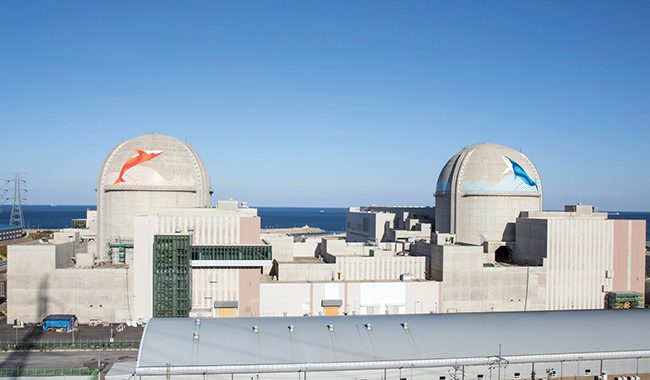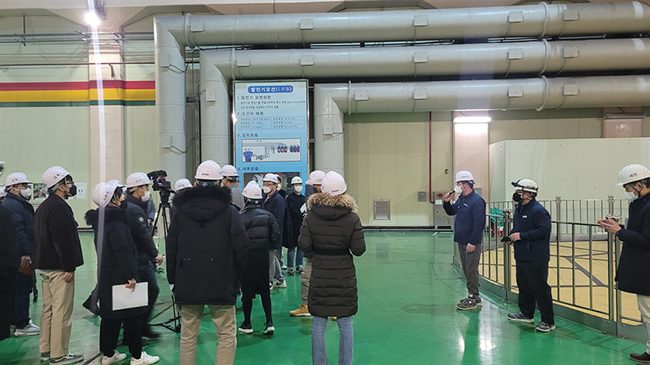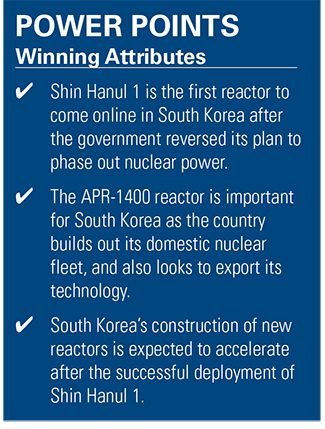Shin Hanul Provides First Step in South Korea’s Nuclear Renaissance
 |
Government officials have reversed the country’s planned phase-out of nuclear power and are now making commitments to deploy domestic reactor technology across the country and abroad.
South Korean officials have said nuclear power is key to supplying electricity for the country’s future energy demand. Officials in July of this year, at a meeting of South Korea’s Ministry of Trade, Industry, and Energy (MOTIE), said, “recent mid- to long-term changes in power supply and demand conditions” highlight the need for more nuclear power and renewable energy generation. The agency noted power demand is increasing across several sectors, including for charging electric vehicles, supplying electricity for data centers, and to spur more investment in high-tech industries including semiconductor and battery manufacturing—both major sectors in South Korea.
Officials with the MOTIE committee said South Korea’s 10th Electricity Plan, also known as the Basic Plan for Long-term Electricity Supply and Demand (BPLE), was correct in targeting a “renewable energy supply goal and restoring the role of nuclear power plants in the power mix.” The plan covers the period of 2022 to 2036. The committee also said, “As electricity demand is expected to increase rapidly due to electrification of industry and life and investment in hi-tech industries, it is necessary to review a new power mix plan including new nuclear power plants.”
 |
|
1. A group tours the Shin Hanul nuclear power plant in South Korea in December 2022, just after Unit 1 at the facility came online. Courtesy: Korea Hydro & Nuclear Power |
The plan for nuclear power is proceeding in earnest. The country’s newest operating reactor is Unit 1 at Shin Hanul, which entered commercial operation in December 2022 (Figure 1). Unit 2 at the site is expected to come online early in 2024; fuel loading for that unit was finished in September 2023. (Editor’s note: Unit 2 began supplying electricity to the grid in January 2024.) Both units feature APR-1400 pressurized water reactors (PWRs) principally designed by Korea Engineering Co.
“The APR-1400 reactor technology is central to South Korea’s nuclear ambitions,” said Seth Grae, CEO of Virginia-based Lightbridge Corp., a nuclear fuel technology development company. “It is the main technology to new nuclear power plants in South Korea and for bids to deploy in other countries.”
According to Korea Hydro & Nuclear Power (KHNP), which operates the nuclear plant, Units 1 and 2 at Shin Hanul are the first in South Korea where all the key equipment—including the reactor technology—was produced domestically. KHNP said Shin Hanul 1 is the country’s first reactor to achieve what it called “technological independence … through localization of core facilities, such as the reactor coolant pump and the plant instrumentation and control system.”
Commercial operation of Shin Hanul 1 also marked a milestone for South Korea’s new energy strategy, reversing a prior plan to move away from nuclear power. That’s among several reasons Shin Hanul is receiving a POWER Top Plant award, as South Korea seeks to play a larger role in the global nuclear power industry.
Expanding Nuclear Power
South Korea has been expanding its nuclear power program after President Yoon Suk Yeol took office in May of last year. Yoon quickly reversed former President Moon Jae-in’s policy of phasing out nuclear power. Moon’s administration, hearing concerns about nuclear power after the Fukushima incident in Japan in 2011, and amid a scandal over forged documents related to tests and inspections of the country’s reactor fleet, said South Korea would reduce its nuclear power generation capacity.
Among the first actions of Yoon’s new government was a restart of construction on Units 3 and 4 at Shin Hanul; work on those units had been suspended in 2017 by Moon’s administration. Yoon in July of last year said he would encourage a rapid revival of what he called South Korea’s “nuclear power plant ecosystem.”
The country’s 10th Electric Plan, published earlier this year, outlined how nuclear energy’s share of South Korea’s generation mix would increase to nearly 35% during the next decade. That would include continued operation of 12 older reactors, along with four new units at Shin Hanul, and two new units at Shin Kori (now called Saeul). Data showed nuclear power generating capacity would increase from 24.7 GW in 2022, to 28.9 GW in 2030, and to 31.7 GW in 2036.
The plan also said South Korea should export its nuclear technology for at least 10 new reactors by 2030, and called for development of small modular reactors. Korea Electric Power Corp. (KEPCO) earlier this year submitted a proposal to Turkey to be part of a project to build four APR-1400 nuclear reactors in that country. Those are important steps for South Korea’s recommitment to nuclear power, but what does it mean for the country when it comes to the global nuclear power market?
“We don’t know for certain,” said Grae, who told POWER that “prior to invading Ukraine in 2022, Russia was in the lead position to win many nuclear power plant deployments.” Grae noted that Finland, Slovakia, and Jordan have now dropped plans to move ahead with Russian reactors, and said that “other countries that had not yet started a procurement process might leave Russia out.”
Grae added, “China’s aggressive actions are making its companies less likely to be reactor vendors to some countries in east Asia that are interested in nuclear power, including the Philippines and perhaps Vietnam. Russia and China receding a bit from prominence as reactor vendors opens opportunities for competitors, including from South Korea.” Grae said France, long a leader in nuclear technology, is experiencing cost overruns and schedule delays in deploying its EPR (European Pressurized Water Reactor) technology in the UK, which could hamper its future plans for nuclear power.
“South Korea also benefits from successful deployment of reactors in the United Arab Emirates [UAE],” said Grae. “With the fourth unit there [at Barakah] scheduled to open in the first quarter of 2024, there are companies and individuals from South Korea who have worked on that project and on projects in South Korea who can successfully do the complex large welding, electrical work, concrete pours, etc. that have not always been done right by other companies and resulted in schedule delays and cost overruns.”
Reactor Evolution
The APR-1400 is an evolutionary PWR and Generation III reactor, with origins in the Combustion Engineering (CE) System 80+ model that was first developed 30 years ago by incorporating improvements into the System 80 design already in operation at the Palo Verde Nuclear Generating Station in Arizona. The APR-1400 produces 1,400 MWe, and has a 60-year design life. It supersedes the standardized 995-MWe OPR-1000 design, a Generation II reactor designed by KHNP and KEPCO.
The APR-1400 was first deployed for Units 3 and 4 at the renamed Saeul site in South Korea, with Unit 3 entering commercial operation in 2016 and Unit 4 coming online in 2019. As Grae noted, the Barakah nuclear power plant in the UAE also features the APR-1400, with three of four units at that site now in operation. Barakah received a POWER Top Plant award in 2021.
The Shin Hanul Unit 1 APR-1400 PWR reached first criticality on May 22 of last year, according to KHNP, a decade after construction began. Groundbreaking for Unit 1 and Unit 2 at the Shin Hanul site occurred in May 2012. First concrete for Unit 1 was poured in July 2012; foundations for Unit 2 followed in June 2013.
Several delays during construction of both Units 1 and 2 extended the timeline to bring the reactors online. The initial schedule called for Unit 1 to enter service in April 2017, with Unit 2 following a year later. Some of the delays were due to numerous safety checks by the country’s Nuclear Safety and Security Committee. Others were due to rigid testing by KHNP.

Along the way, other groups supported deployment of the APR-1400. European Utility Requirements, a technical advisory group for European utilities on nuclear power plants, in October 2017 approved the reactor design. The U.S. Nuclear Regulatory Commission certified the APR-1400 in August 2019, finding the design fully meets U.S. safety requirements.
KHNP and Doosan Enerbility in March of this year signed a $2.2 billion supply contract for the main equipment for Shin Hanul Units 3 and 4. Doosan Enerbility will supply the nuclear reactors, steam generators, and turbine generators for the two APR-1400 reactors. Shin Hanul Unit 3 is scheduled to be completed by 2032, and Unit 4 by 2033.
In addition, KEPCO earlier this year submitted a proposal to Turkey to be part of a project to build four APR-1400 nuclear reactors in that country. Grae noted that bringing Shin Hanul Unit 1 online, and with several other projects moving forward, South Korea has an opportunity to showcase its nuclear technology on the world stage.
“A competitive advantage to South Korea is prospective customers can feel confident about costs and timeframes, by dealing with Korean companies and individuals within those companies who are successfully deploying an APR-1400 in the UAE right now and have recently deployed multiple additional APR-1400 units,” he said.
—Darrell Proctor is a senior associate editor for POWER (@POWERmagazine).